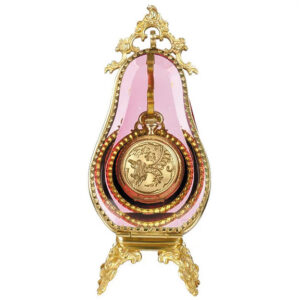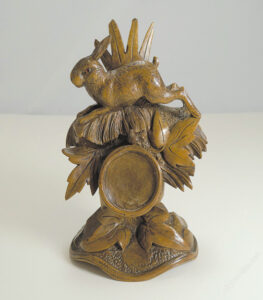 By Anne Gilbert
By Anne Gilbert Chances are you wouldn’t recognize a watch stand if you saw one. At first glance some look like small picture frames. The frames may be figural or even of a precious metal. They belong to a bygone era when watches were somewhat of a novelty and meant to be displayed when not worn. When they come to auction they may be referred to as a watch stand, watch hutch or watch holder.
They are being rediscovered as unique collectibles. Never mind if you don’t collect pocket watches, the stands that displayed them are a fascinating collectibles category.
Watch stands were as practical as they were decorative. When a delicate 18th or 19th century watch wasn’t carried in a pocket it needed a protective display case. The pocket watch was after all a status symbol, like today’s Rolex.
Watch stands originated in Europe and were imported to America between 1725 and 1850. At that time watches were prized as mechanical wonders and usually owned only by the wealthy. Customarily women wore them attached to a chatelaine that was hung from the waist. The chatelaine was a chain girdle that held everything from scissors to scent bottles. Men carried watches suspended on a long chain.
By the end of the 17th century watch mechanisms evolved, becoming more delicate, influenced by changes in temperature and vibrations. Either of these could upset the time keep mechanisms. They could no longer be hung on chains. Now, the watches needed to be protected. The creation of the watch stand solved the problem. Early versions had a rear pocket that held the watch and a circular opening in the front to display the face. Some were also designed to hold the thicker French watches. By the early 19th century less expensive watches were being made and affordable holders as well.
However, many late 19th century watches were thinner didn’t fit into these holders, so, once again the form of the holder changed as did the materials. Figurals of pottery, metals or wood were popular, as well as glass examples. For the wealthy precious stones and metals were used.
 CLUES: You can still find holders at auctions or retail settings. Collectors are finding the Staffordshire figural stands fun collectibles. A real discovery would be a 19th century Meissen porcelain holder. You can recognize them by the combination of a fine piece of Meissen sculpture, aligned with a circular holder and signature. The more unusual the carving, the more expensive and desirable the piece. Some 19th century items made of precious metals and stones can fetch several thousand dollars at auction. Others can be offered on eBay for under $100.
CLUES: You can still find holders at auctions or retail settings. Collectors are finding the Staffordshire figural stands fun collectibles. A real discovery would be a 19th century Meissen porcelain holder. You can recognize them by the combination of a fine piece of Meissen sculpture, aligned with a circular holder and signature. The more unusual the carving, the more expensive and desirable the piece. Some 19th century items made of precious metals and stones can fetch several thousand dollars at auction. Others can be offered on eBay for under $100. Depending on what style they are they can fit into a specific category. For instance if handcarved they could be part of a folk art collection. If they are in the early Art Deco style they could become part of a Mid-Century Modern collection.
The good news for collectors is that they are out of fashion and often can be found unrecognized and underpriced.
PHOTO CAPTION; (1) Pocket watch stand. Carved rabbit, Black Forest, Germany. PHOTO CREDIT: ANTIQUES ATLAS, UK. PHOTO CAPTION: (2) Cran-berry glass watch stand. PHOTO CREDIT: Heidelberg Fine antiques. Heidelberg MS.















Follow Us